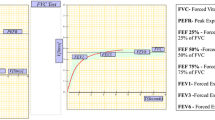Abstract
An artificial neural network was trained in the recognition of asthmatics in a general practice population, employing crossvalidation on a subset of 350 patients of known asthmatic status. The trained network was then run on the data from 3139 patients whose asthmatic status was unknown. Using the values from the test set as estimates of sensitivity and specificity, the number predicted positive was adjusted to allow for false positives and false negatives to give an estimate of asthma prevalence and the minimum underdiagnosis rate that this suggested for the population. Using different data sets and network structures, prevalence rates of approximately 16–21% were measured providing evidence, even after allowing for maximum variablity in the estimates, consistent with under-diagnosis of at least a small percentage (0.7–4.0%). To provide a more precise estimate of the rate of this under-diagnosis and associated prevalence, a larger training and testing set of more accurately labelled cases is planned.
Similar content being viewed by others
References
Jones K. Asthma — still a challenge for general practice. J Roy Col Gen Practit 1989;39; 254–56
Asthma's changing prevalence. BMJ 1992;304: 857–858
Gregson M, John R, Teather BA, Thompson R. Practical issues in the application of neural networks to the differential diagnosis of brain disease. Proc Int Conf on Neural Networks and Expert Systems in Medicine and Healthcare, August 1994
Jarvis D, Lai E, Luczynska C, Chinn S, Burney P. Prevalence of asthma and asthma-like symptoms in young adults living in three East Anglian towns. Br J Gen Pract 1994;44: 493–497
Weiss SM, Kulikowski CA. Computer Systems That Learn. San Francisco, Morgan Kaufmann, 1991, 31–33
Weiss SM, Kulikowski CA. Computer Systems That Learn. San Francisco, Morgan Kaufmann, 1991, 44–46
Fleming DM, Crombie DL. Prevalence of asthma and hay fever in England and Wales. BMJ 1987;294: 279–283
Peat JK, Haby M, Spijker J, Berry G, Woolcock AJ. Prevalence of asthma in adults in Busselton, Western Australia. BMJ 1992;305: 1326–1329
Laor A, Cohen L, Danon YI. Effects of time, sex, ethnic origin, and area of residence on prevalence of asthma in Israeli adolescents. BMJ 1993;307: 841–844
Author information
Authors and Affiliations
Rights and permissions
About this article
Cite this article
Hirsch, S., Shapiro, J. & Frank, P. Use of an artificial neural network in estimating prevalence and assessing underdiagnosis of asthma. Neural Comput & Applic 5, 124–128 (1997). https://doi.org/10.1007/BF01501176
Issue Date:
DOI: https://doi.org/10.1007/BF01501176



